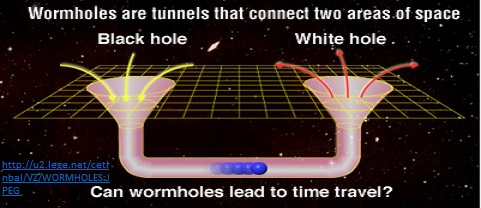Wormholes:
The idea of a wormhole is extremely complex. While they may seem to be a science fiction dream, they do exist. When Einstein discovered the laws of General Relativity, It allowed for the existence of wormholes. When thinking of wormholes, it's good to think of action and reaction forces. As a person pushes on a wall, Newton's third law tells us that the wall also pushes back. A black hole is an area where a mass is so dense, that nothing can escape the gravitational pull. This can be described as thousands of suns mashed together to the size of a grain of sand. Since the masses of the objects being pulled in multiplied by the gravitational pull of the black hole creates a force towards the black hole, the black hole must have an opposite that releases these forces and energy. This release is given by something called a white hole. According to Dr. Andrew Hamilton at the University of Colorado Boulder, there are a few problems with the idea of a white hole (Read here). Most namely, they can't exist due to the second law of thermodynamics. That being said, the theoretical white hole technically could exist due to the fact that it would have to exist in a different universe. The laws of physics are universal, but we are unable to know if the laws of physics exist everywhere, or even if they evolve with time.

http://u2.lege.net/cetinbal/VZ/worm9.gif
The problem with wormholes are the same thing that make them possible. When wearing wool socks on carpet, the electrons build and build until you finally touch metal and it discharges. The same idea applies within a black hole. The energy builds and builds until it must discharge. This leads to the opening of the wormhole where the connected universe acts as the door knob. Like the brief shock you get when touching the door handle, the opening of the wormhole is just a brief. The energy of a collapsing wormhole would tear anything in the center into pieces.
More on the idea of a wormhole can be found here.

